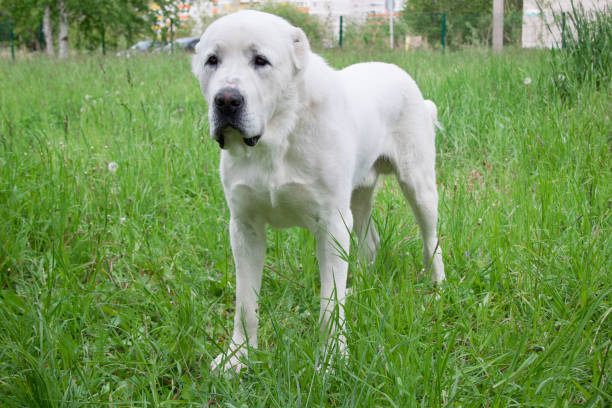Alabai

Breed History:
The Alabai, also known as the Central Asian Shepherd Dog, is an ancient and powerful breed with roots in Central Asia, spanning countries like Kazakhstan, Uzbekistan, Turkmenistan, and parts of Russia. Bred for centuries to guard livestock against predators such as wolves, bears, and jackals, the Alabai has earned a reputation for its bravery, strength, and resilience in harsh climates and rugged terrains.
This breed developed naturally over thousands of years through the selective pressures of survival, rather than human-directed breeding, resulting in a hardy and independent guardian dog. Deeply ingrained in the pastoral culture of Central Asia, the Alabai is not just a working dog but a revered symbol of protection and loyalty. Despite its fierce guarding instincts, the breed can be calm and devoted to its family when properly socialised and trained.
|
Gender |
Height |
Weight |
|
Male |
70 cm |
50–79 kg |
|
Female |
65 cm |
40–65 kg |
Size – Large
Life Expectancy: 12–15 years

Breed Appearance:
The Alabai is a large, muscular, and imposing dog with a rugged, powerful build designed for endurance and strength. It has a broad head, strong jaw, and thick neck, conveying its heritage as a fearless guardian. Its double coat, which can be short or moderately long, provides excellent protection against both extreme cold and heat, and it comes in a variety of colours including white, black, fawn, brindle, and grey.
Its thick tail curls over the back, and its sturdy limbs and deep chest give it an athletic appearance. The Alabai’s expression is confident and alert, with small, deep-set eyes and a calm but watchful gaze. It is a breed that commands attention through sheer presence, exuding strength and stability.
Breed Type – Family/Guard:
Primarily a livestock guardian, the Alabai is known for its territorial instincts and natural suspicion of strangers. It is extremely loyal to its family and protective of its home, often forming a deep bond with its owners. With early socialisation, the Alabai can live peacefully with children and other household animals, but it requires clear boundaries and consistent leadership.
This breed is not suitable for first-time dog owners due to its dominant and independent temperament. It thrives under the guidance of an experienced handler who understands working breeds and can establish authority through calm, assertive training. Though naturally independent, the Alabai is deeply attached to its family and excels as a watchdog and loyal companion in the right environment.

Training:
Training the Alabai requires a firm, consistent approach, as the breed is highly intelligent but strong-willed. It does not respond well to harsh discipline but instead benefits from calm, confident leadership and positive reinforcement. Early and extensive socialisation is essential to reduce territorial aggression and ensure it can distinguish between a real threat and harmless visitors.
Given its natural guarding instincts, the Alabai often makes decisions on its own, especially when left unsupervised. It is crucial to start obedience training early and maintain it throughout its life. The breed is not suited for off-leash activities in open, unsecured areas due to its protective drive and tendency to patrol large territories.
Health & Care:
The Alabai is a generally healthy breed, thanks to its natural evolution over generations. It is less prone to many inherited conditions, but large breeds like this can still face issues such as hip dysplasia, elbow dysplasia, and bloat (gastric torsion). Regular vet check-ups and maintaining a healthy weight are important for long-term joint health.
Its coat is relatively easy to care for, requiring weekly brushing to remove dead hair and dirt. Shedding occurs seasonally, during which grooming should be increased. A well-balanced diet, moderate exercise, and parasite control contribute to the Alabai’s long and robust life.

Living Conditions:
The Alabai is best suited for homes with large, securely fenced outdoor areas where it can roam and patrol freely. It is not a good candidate for apartment living due to its size, protective instincts, and need for space. A working environment, such as a farm or ranch, is ideal, where the dog can fulfil its natural role as a guardian.
Though independent, the Alabai requires daily interaction with its family to remain well-adjusted. It should never be isolated or left tethered for long periods, as this can lead to behavioural issues. It is a quiet breed by nature, barking only when necessary, typically in response to perceived threats or unfamiliar activities.
Exercise:
The Alabai has moderate exercise needs but thrives on purpose-driven activity. It benefits from daily walks and secure outdoor time where it can survey its territory. Despite its size, it is not hyperactive and is content with structured exercise rather than constant stimulation.
Mental stimulation through training, scent work, or interactive toys is equally important, as the Alabai can become bored or destructive without adequate engagement. Exercise should be managed to prevent joint stress, particularly during growth periods or old age. It tolerates cold weather well but should not be overworked in extreme heat due to its dense coat and large frame.
Grooming:
The Alabai’s thick, weather-resistant coat is relatively low-maintenance but does require weekly brushing, particularly during seasonal shedding in spring and autumn. This helps control loose hair and keeps the coat and skin healthy. Areas behind the ears and under the limbs should be checked regularly for matting or debris.
Bathing should be infrequent—only when dirty or necessary—to preserve the natural oils that protect its coat. Regular nail trimming, ear cleaning, and dental care are important to avoid infections and maintain overall health. Due to its working nature, checking for ticks and other parasites is especially important after outdoor activities.

Advantages:
-
Natural guardian instincts make it an excellent protector of property and livestock
-
Highly loyal and bonded with family, forming strong protective attachments
-
Independent and intelligent, capable of making its own decisions in the field
-
Low grooming needs relative to coat thickness; seasonal shedding is manageable
-
Quiet and non-destructive indoors when properly exercised and socialised
-
Hardy breed, well-adapted to various climates, especially cold weather
Disadvantages:
-
Not recommended for inexperienced dog owners due to its dominant, independent nature
-
Requires early socialisation and consistent training to manage territorial instincts
-
Needs ample space; unsuitable for apartment living or sedentary households
-
May be aggressive toward unfamiliar animals or strangers if not properly trained
-
Tends to patrol and wander if not securely fenced—strong prey and guarding drive
-
Sensitive to overexertion in hot climates due to a thick coat and large size

